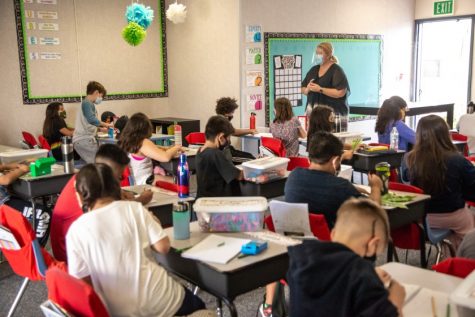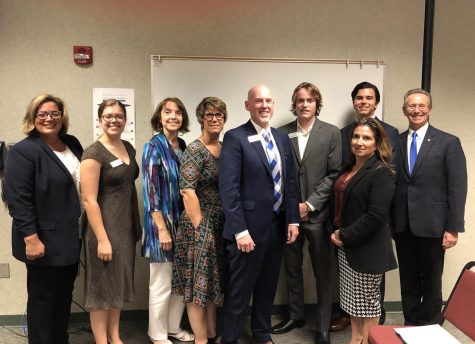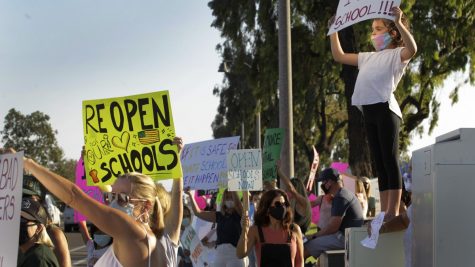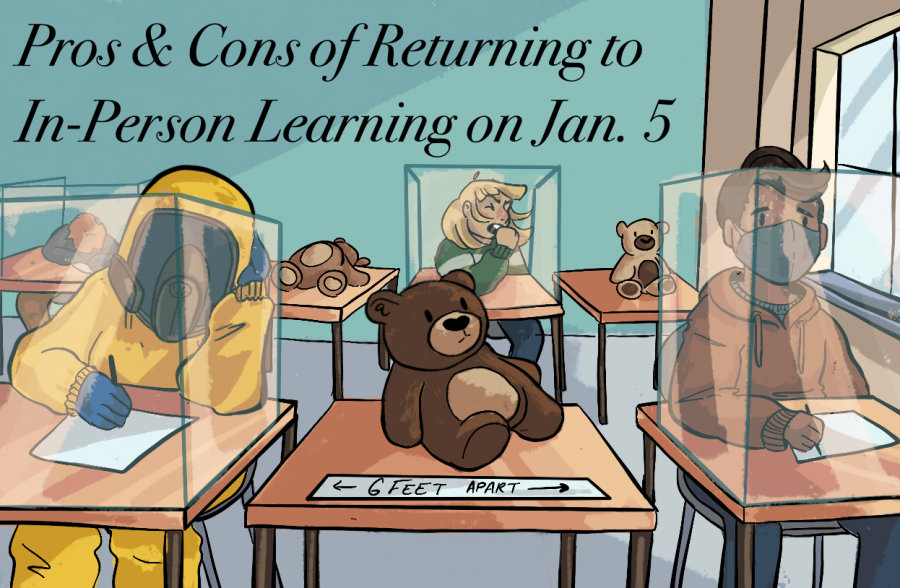(Illustration by Tiffany Leyva)
Students sitting in a classroom with a classroom with new COVID-19 restrictions. Carlsbad Unified School DIstrict deemed their high schools and middle schools would return to in-person learning on Jan. 5. The decision has been controversial due to varying levels of health concerns for families and staff.
The Pros and Cons of The School Board’s Decision to Return to In-Person Learning on Jan. 5
Nov 19, 2020
The Carlsbad Unified School District’s decision to reopen in schools in January is perceived as both a positive decision and a negative decision. On one hand, it’s a relief to families and staff who are at risk for COVID-19. As the nation braces for the ninth month of the pandemic it is apparent that the public is growing tired of the virus. Although it may seem appealing to disregard the pandemic in favor of returning to “normal,” returning to in-person learning only to promptly go back to online learning can cause unnecessary collateral damage on the health of the community and the mental health of students.
Contrarily, there is the viewpoint that CUSD must reopen schools if it prioritizes the success and health of students. According to the CUSD, there has been an 8.7% increase in the amount of failing grades issued in 2020, compared with the 2019 school year and mental health has been of great concern as well. Across the country schools have been open since August, yet the CUSD refuses to reopen schools to the detriment of students’ grades, and mental health.
Pros about School Board Decision
In a situation where it’s a matter of life and death, it’s important to pick the path that will lead to the least amount of collateral damage. Opening schools prematurely only to promptly close them back again whilst the U.S. is experiencing a surge in cases is just going to cause nothing but heartbreak for students, families, and staff alike.
It is no secret that in the United States, COVID-19 has ravaged throughout the country, infecting 10.2 million people and creating a seemingly endless lockdown for those who have been responsible. It is understandable that people, high schoolers especially, are anxious to return back to life prior to the pandemic where they interacted with more people than just their families. However, the public doesn’t get to decide the pandemic is over just because they’re over it. We have to listen to science.
For students, parents, and staff who desperately want to be back at school, the news of Carlsbad Unified School Board sticking with their original plan of returning to in-person learning on Jan. 5 may be disheartening. But for at-risk and/or concerned families, the news gave them a sense of relief.

Since the very beginning of the pandemic, I have been anxious about returning to in-person learning due to the possibility of bringing the virus back home to my at-risk father and seeing him pass away. The options for students were limited to transferring to Carlsbad Seaside Academy (CSA), which is set to stay online all year, or stay at Sage Creek and risk having to go back.
For students like junior and former Sage Creek student, John Sweeney, transferring to CSA was the more preferable option.
“[Transfering] was really more my mom’s decision,” Sweeney said. “She is really at risk for COVID and she was thinking that… if things go back to school she doesn’t want us to be exposed to that many people.”
But for seniors applying for college, transferring is not the preferable option. My family decided it would not be the smartest move to transfer for academic consistency, application support, and because I wanted to graduate with my class.
Senior Lilly Schleifer chose to stay enrolled at Sage Creek for similar reasons, in addition to CSA’s lack of AP classes. She and her brother Dr. Benjamin Schleifer, a pediatrician, have been concerned with the spread of the virus since their parents are older and are at-risk.
“A lot of parents are healthy, they’re in the low-risk age group and they feel comfortable sending their kids to school,” said Dr. Shelifer. “If they get sick and bring it home, they’re not too worried about getting severely sick with it. That is not the case for all parents. Our parents are in the high-risk group and that may not be the vast majority of parents…of high school kids… but when… mixed with the community, it definitely increases COVID risk [of] bringing it home.”
Returning back to school should not be something rushed into because it is something that can unnecessarily endanger families in the community that don’t have a choice. Going back prematurely can also be disheartening for students who are experiencing quarantine fatigue and struggling with mental health. A student could go back thinking, “maybe the pandemic is almost over” just to have their morale crushed by schools shutting down again, having support systems ripped away from them and feeling even more isolated.
In a survey conducted by the CDC in June found that 11 percent of all respondents said they had “seriously considered” suicide in the past 30 days. As for those who are between the ages 18 to 24, the number was 1 in 4.
A failed attempt of returning to in-person learning could be the tipping point that pushes someone over the edge. The death of a student brings even more trauma for peers and a rise in suicide rates. This is why it is imperative to return to schools correctly the first time.
Unfortunately, returning back to school in the tristate area has not been successful.
The schools in the Vista Unified School district began in-person learning on Oct. 20, and promptly returned to virtual learning after a week due to 18 students and staff being infected with COVID-19 across 13 of their campuses.
“It’s such a disruptive system for kids to go under quarantine, come back in, go under quarantine, come back in,” Keri Avila, president of the Vista Teachers Association, told NBC San Diego. “How can we bring down the anxiety of our community when there’s such a disruption of student learning?”

School schedules have changed drastically during online learning, especially at Sage Creek High School with a shift from a 70 minute class periods from 7:30 A.M. to 2:30 P.M., with an 8:30 A.M. late start on Wednesdays to a block schedule with classes alternating on the daily from 8:00 A.M. to 1:35 P.M. For students who had to wake up at 5:30 A.M and drive 30 minutes or more to get to school, had to be dropped off early so their parents could get to work on time, or simply wanted more sleep, the new schedule has definitely been a positive for students.
With the 7:30 A.M. start time and copious amounts of homework, the average student will get 7 hours of sleep, but for peers and myself it could range from 15 minutes and 5 hours of sleep. There were days last year where I ran off of 15 minutes of sleep for 36 hours. Now with a first period off roll and the online schedule I get a full eight hours which is the CDC recommended amount for students.
Going back to school now and being forced to go home again would feel like a shock to the system as well as a repeat of the initial school closures on March 13. Classrooms; filled with anxious students wondering what’s going to happen to their friends and families, not knowing when they’ll see each other again.
Personally, I would not like to relive that glum day, regardless of how much I wish I could have a traditional senior year, where my biggest worries are getting into a good college, finding a cute prom dress and wondering how I’m going to make my life into a John Hughes movie. But unfortunately that’s just not the case and no amount of denial is going to change it.
“I would… 100% be thinking, ‘I’m going to get sick, I’m going to die,’ instead of understanding what the teachers were talking about,” sophomore Liza Turovets admits.
Although 10-19 year olds only make up 10% of COVID-19 cases in San Diego county, the youth’s biggest worry is undoubtedly getting infected and seeing loved ones die. In any case, no one should have to think that.

Why should students and teachers go back in favor of short-lived gratification for some that would put the community as a whole at risk and could potentially devastate our community? With mental health on the edge and plans being left in the air, it’s easy to feel as if everything is out of control, especially since San Diego County has officially reached the purple tier on Nov. 10. Now, more than ever, it’s important for people to focus on the things people can control right now.
As a community, we can control how the pandemic affects us mentally by maintaining connections and checking up on one another. As a community, we can control long the pandemic lasts by social distancing and wearing masks. And if the community can control the spread, care for one another and listen to science, schools can reopen when it’s 100% safe for all and can stay open.
Cons of School Board Decision
The decision by the Carlsbad Unified School District to return to school on Jan. 5, 2021, is detrimental to the students of Sage Creek and their academic future. According to the California Department of Public Health, among schools that have reopened, there have been a “very small” number of COVID-19 cases. Across the United States, classes are taking place in person, and have been since Aug. 31.

CUSD must reopen schools if they truly have students’ best interests in mind.
According to a CUSD update published on Oct. 30, over the last two months, the percentage of failing grades issued has reached 14.3%, an 8.7% increase in the amount of failing grades issued compared with the 2019 school year.
“I think that students need to be back in school as soon as possible,” senior Isaac Perez said. “The overall experience of online learning has made me not like learning anymore.”
The CUSD acknowledges that there is an undeniable correlation between lower grades and online school, and yet they refuse to open schools earlier to the detriment of students, particularly those in disadvantaged demographic groups.
With widespread educational disparities across demographic groups in California, students of color at Sage Creek may be the most affected. In an article published by CalMatters, on Feb. 3, they found that “black, Latino and poor students still lag dramatically behind Asian American, white and wealthier students.” Schools remaining closed could worsen educational disparities in our community due to lower test scores among students of color, and little progress to fix gaps in education.

The CUSD board’s decision to remain at home for the remainder of 2020 is not only negatively impacting students, it is subjecting the most vulnerable members of our community to increased academic pressure, which has resulted in lower grades among all students and Sage Creek, students of color, or otherwise.
According to a Center for Disease Control article published on Oct. 29, “children with COVID-19 are less likely to have severe symptoms than adults or experience an asymptomatic infection.” Coupled with the “very small” number of COVID-19 cases that have occurred in schools that have reopened, and the CDC’s statement that children are “less likely to have severe symptoms,” it is irresponsible for the CUSD to continue online school, as students are already struggling to achieve academic success.

